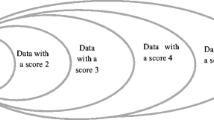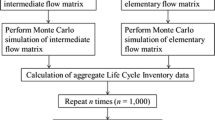Abstract
Modelling data uncertainty is not common practice in life cycle inventories (LCI), although different techniques are available for estimating and expressing uncertainties, and for propagating the uncertainties to the final model results. To clarify and stimulate the use of data uncertainty assessments in common LCI practice, the SETAC working group ‘Data Availability and Quality’ presents a framework for data uncertainty assessment in LCI. Data uncertainty is divided in two categories: (1) lack of data, further specified as complete lack of data (data gaps) and a lack of representative data, and (2) data inaccuracy. Filling data gaps can be done by input-output modelling, using information for similar products or the main ingredients of a product, and applying the law of mass conservation. Lack of temporal, geographical and further technological correlation between the data used and needed may be accounted for by applying uncertainty factors to the non-representative data. Stochastic modelling, which can be performed by Monte Carlo simulation, is a promising technique to deal with data inaccuracy in LCIs.
Similar content being viewed by others
Explore related subjects
Discover the latest articles and news from researchers in related subjects, suggested using machine learning.References
Beccali G, Beccali M, Cellura M (1997): Fuzzy set application in life cycle inventory of building materials. Paper. Building and the Environment: Proceedings of the Second International Conference. Volume 1: Assessment methods and natural resources. Centre Scientifique et Technique du Bâtiment, Paris
Boustead I (1993): Eco-profiles of the European plastics industry. Report 3: polyethylene and polypropylene. Association of Plastics Manufacturers in Europe (APME), European Centre for Plastics and the Environment (PMWI), Brussels
Boustead I (1997): Eco-profiles of the European plastics industry. Report 9: polyurethane precursors (TDI, MDI, Polyols). Second edition. Association of Plastics Manufacturers in Europe (APME), European Isocyanate Producers Association (ISOPA). Brussels
Bretz R, Fankhauser P (1996): Screening LCA for large numbers of products: estimation tools to fill data gaps. Int J LCA 1 (3) 139–146
Burmaster DE, Anderson PD (1994): Principles of good practice for the use of Monte Carlo techniques in human health and ecological risk assessments. Risk Analysis 14 (4) 477–481
Carnegie Mellon University (1999): Economic input-output life cycle assessment. http://www.eiolca.net/
Chevalier JL, Le Téno JF (1996). Life cycle analysis with ill-defined data and its application to building products. Int J LCA 1 (2) 90–96
De Beaufort ASH, Bretz R (eds.) (2001): Code of life cycle inventory practice. SETAC WG ‘Data Availability and Data Quality’. SETAC-Europe, Brussels (forthcoming)
EC (1996): Technical Guidance on in support of Commission Directive 93/67/EEC on risk assessment for new notified substances and Commission Regulation (EC) No. 1488/94 on risk assessment for existing substances 2nd part. Brussels, Commission of the European Communities, Directorate-General Environment, Nuclear Safety and Civil Protection
Fava J, Jensen AA, Lindfors L, Pomper S, De Smet B, Warren J, Vigon B (1994): Life-cycle assessment data quality: a conceptual framework. Society of Environmental Toxicology and Chemistry-Europe. Pensacola, Florida
Finnveden G, Lindfors LG (1998): Data quality of life cycle inventory data-rules of thumb. Int J LCA 3 (2) 65–66
Frischknecht R, Hofstetter P, Knoepfel I, Menard M, Dones R, Zollinger E (eds.) (1996): Ökoinventare für Energiesystemen. Grundlagen für den ökologischen Vergleich von Energiesystemen und den Einbezug von Energiesystemen in Ökobilanzen für die Schweiz. Eidgenössische Technische Hochschule, Zürich
Habersatter K (ed.) (1991): Ökobilanz von Packstoffen, Stand 1990, Swiss Bundesamt für Umwelt, Wald und Landschaft (BUWAL), Schriftenreihe Umwelt Nr. 132. Bern
Habersatter K, Fecker I (eds.) (1998): Ökoinventare für Verpackungen Vol. I + II, Swiss Bundesamt für Umwelt, Wald und Landschaft (BUWAL), Schriftenreihe Umwelt Nr. 250/I+II, Update and corrections. Bern
Heijungs R (1996): Identification of key issues for further investigation in improving the reliability of life cycle assessments. J Cleaner Prod 4 (3–4) 159–166
Hendrickson C, Horvath A, Joshi S, Lave L (1998): Economic input-output models for environmental life-cycle assessment. Environ Sci Tech 32 (7) 184A-191A
Hischier R, Bretz R, Baitz M, McKeown P, Oele M, Renner I, Reusser L, Wessman H, Huybrechts D, Moessner S, De Beaufort ASH (2001): SETAC-Europe LCA Working Group, Data Availability and Data Quality, ‘Standardized Lists of Interventions’. Int J LCA (forthcoming)
Hoffman L, Weidema BP, Kristiansen K, Ersball AK (1995): Statistical analysis and uncertainties in relation to LCA. Special reports no. 1. Nordic Council of Ministers. Copenhagen
Huijbregts MAJ (1998a): Application of uncertainty and variability in LCA. Part I: A general framework for the analysis of uncertainty and variability in life-cycle assessment. Int J LCA 3 (5) 273–280
Huijbregts MAJ (1998b): Application of uncertainty and variability in LCA. Part II: Dealing with parameter uncertainty and uncertainty due to choices in life-cycle assessment. Int J LCA 3 (6) 343–351
Janssen PHM, Slob W, Rotmans J (1990): Gevoeligheidsanalyse en onzekerheidsanalyse, een inventarisatie van ideeën, methoden en technieken (in Dutch). Report no. 958805001. National Institute of Public Health and the Environment, Bilthoven
Kennedy DJ, Montgomery DC, Quay BH (1996): Data quality. Stochastic environmental life cycle assessment modelling. A probabilistic approach to incorporating variable input data quality. Int J LCA 1 (4) 199–207
Maurice B, Frischknecht R, Coehlo-Schwirtz V, Hungerbühler K (2000): Uncertainty analysis in life cycle inventory. Application to the production of electricity with French coal power plants. J Cleaner Prod 8 (2) 95–108
Morgan MG, Henrion M, Morris SC Amaral DAL (1985): Uncertainty in risk assessment. A case study involving sulfur transport and health effects. Environ Sci Tech 19 (8) 662–667
Morgan MG, Henrion M (1990): A guide to dealing with uncertainty in quantitative risk and policy analysis. Cambridge University Press, New York, NY
Norris GA (1997): An Integrated Economic/Environmental Accounting Analysis System for the USA. In: Regional and National Material Flow Accounting: From Paradigm to Practice of Sustainability. Wuppertal Institute for Climate, Environment, and Energy, Germany
Petersen EH (1997): Life-cycle assessment of building components. Handling uncertainties in LCAs. Paper. Building and the Environment: Proceedings of the Second International Conference. Volume 1: Assessment methods and natural resources. Centre Scientifique et Technique du Batiment, Paris
Ragas AMJ, Etienne RS, Willemsen FH, Van de Meent D (1999): Assessing model uncertainty for environmental decision making: a case study of the coherence of independently derived environmental quality objectives for air and water. Environ Toxicol Chem 18, 1856–1867
Singhofen A, Hemming CR, Weidema BP, Grisel L, Bretz R, De Smet B, Russell D (1996): Life cycle inventory data: development of a common format. Int J LCA 1 (3) 171–178
Suh S (2000): Missing inventory estimation tool (MIET 1.2). http:// www.leidenuniv.nl/cml/ssp/software/
Taylor AC (1993): Using objective and subjective information to develop distributions for probabilistic exposure assessment. J Expos Anal Environ Epidem 3 (3) 285–298
Vose D (1996): Quantitative risk analysis. A guide to Monte Carlo simulation modelling. John Wiley & Sons, West Sussex
Weidema BP (1998): Multi-user test of the data quality matrix for product life cycle inventory data. Int J LCA 3 (5) 259–265
Weidema B P. (1999). The SPOLD file format ‘99. http://www.spold.org/publ/
Weidema BP, Wesnæs MS (1996): Data quality management for life cycle inventories: an example of using data quality indicators. J Cleaner Prod 4 (3–4) 167–174
Author information
Authors and Affiliations
Rights and permissions
About this article
Cite this article
Huijbregts, M.A.J., Norris, G., Bretz, R. et al. Framework for modelling data uncertainty in life cycle inventories. Int J LCA 6, 127–132 (2001). https://doi.org/10.1007/BF02978728
Issue Date:
DOI: https://doi.org/10.1007/BF02978728




